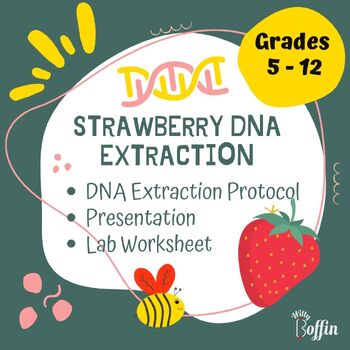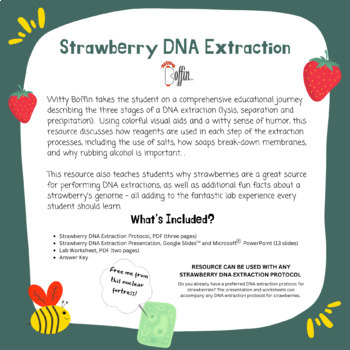Strawberry DNA Extraction Lab, Lab Report Worksheet and Teaching Slides
- Zip
What educators are saying
Description
Discover a fun and exciting way to teach your students about plant and animal cell organelles and structures with the Strawberry DNA Extraction Lab. This biology experiment is perfect for middle school science, high school biology, or AP Biology classrooms, and it's so easy to do that it's also an excellent activity for home-school science. With a no-prep teaching slide presentation, lab report worksheet, and easy-to-follow lab instructions, you'll have everything you need to get started.
Witty Boffin takes the strawberry DNA extraction lab one step further for your students with the teaching slides to help understand the three stages of a DNA extraction (lysis, separation, and precipitation). With the help of colorful visual aids in each slide and a touch of humor, this resource makes it easy to understand how reagents are used in each step of the extraction process, including the use of salts, how soaps break-down membranes, and why rubbing alcohol is important.
Best of all, all you need to do is buy the ingredients and you're ready to go!
Students will get a complete understanding of how DNA extractions work with a no prep plan ready to execute in the classroom. Just need to buy the ingredients.
This resource also teaches students why strawberries are a great source for performing DNA extractions, as well as additional fun facts about a strawberry's genome - all adding to the fantastic lab experience every student should learn.
What's Included:
- Strawberry DNA Extraction Protocol, PDF (three pages)
- Strawberry DNA Extraction Presentation, Google Slides and Microsoft PowerPoint (13 slides)
- Lab Worksheet, PDF (two pages) - Print and Go
- Answer Key
Note: digital resources are not editable.
ALREADY HAVE A DNA EXTRACTION PROTOCOL? THE SLIDE PRESENTATION AND LAB WORKSHEETS CAN ACCOMPANY ANY STRAWBERRY DNA EXTRACTION PROTOCOL.
Start the lesson with a slide presentation that discusses the three important stages of DNA extraction. Each step is identified as to how chemical and physical methods are used to release DNA from the cell.
The easy to follow protocol will guide students to extract DNA from strawberries. Laboratory worksheets allow students to record observations and answer post-lab questions.
In addition:
- Brainstorm activity as to why scientists want to extract DNA from cells;
- Learn why strawberries are an excellent source of DNA compared to other types of organisms;
- A few fun facts about the strawberry genome; and
- Includes a suggested YouTube video about the strawberry octoploid genome to further enhance student's educational experience.
WHY PERFORM THIS LAB?
Many teachers wonder if this is a lab worth pursuing since some students are not "wowed" at seeing DNA. However, the bigger picture for this lab is to teach students the "how" behind DNA extractions. Witty Boffin offers an in-depth experience for this must-do lab with curated materials to easily implement the activity in a middle or high school classroom.
*****************************************************************************
**********************************************************************
Resources You May Like:
What Are Cells? Growing Large-Bundle
Bob's Cell Quest Inquiry Lab - Distance Learning
Bob's Cell Quest Inquiry Lab - Traditional Learning
******************************************************************************************
I LOVE NEW TPT FOLLOWERS!
Thank you so much for choosing my products. Please follow me on TPT! You’ll be the first to know when I post a freebie, a new product, or have an amazing sale! To follow me, go to the top right of this page where you see my logo. Click the little green star it says “Follow Me” and you’re done!
Get the latest information on new products, blogs, and interesting science information to share in your classroom!
Check out our growing website, wittyboffin.com.
FEEDBACK
Did you know that you can receive credit towards future purchases by reviewing this product? If you liked what you got, please leave a review on the product page or through “My Purchases”. If you had an issue or found an inaccuracy, PLEASE contact me at wittyboffin@gmail.com prior to leaving negative feedback. I will do everything I can to ensure you are satisfied! It is important to me that all teachers who choose my products to be 100% happy with their purchase.
COPYRIGHT INFORMATION / TERMS OF USE
Copyright © Witty Boffin, LLC All rights reserved by author. This product is to be used by the original purchaser only. Copying for more than one teacher, classroom, department, school, or school system is prohibited. This product may not be shared, distributed or copied outside the school setting. Failure to comply is a copyright infringement and a violation of the Digital Millennium Copyright Act (DMCA). This product is Intended for classroom and personal use ONLY.





